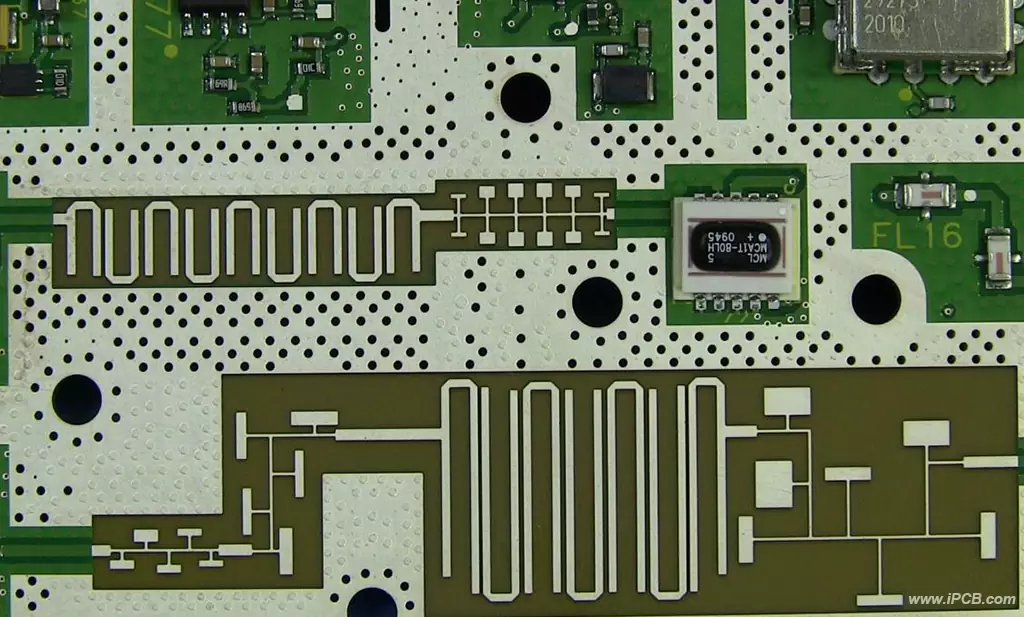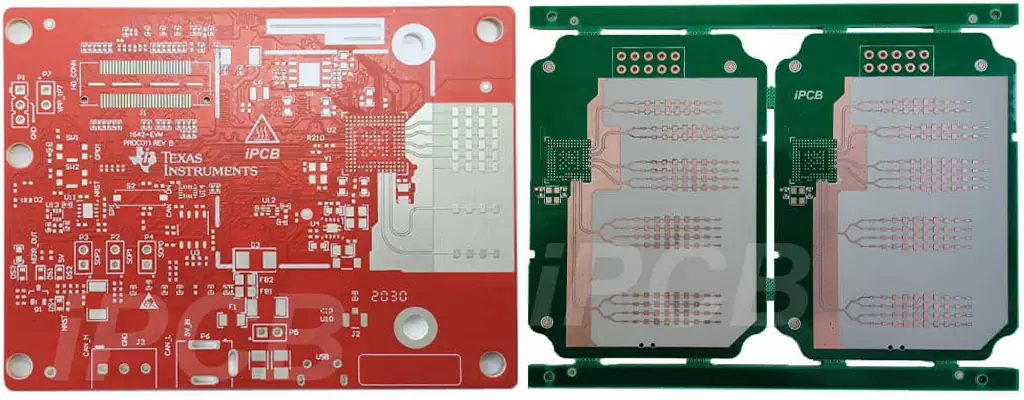Most common composite PCBs use glass fiber as the filler of the dielectric layer.However,due to the special weaving structure of glass fiber, the local dielectric constant (Dk) of the PCB board will change. Particularly at millimeter wave (mmWave) frequencies,where the glass weave effect of thinner circuit boards is more pronounced,local non-uniformities in Dk can cause significant changes in the performance of radio frequency (RF) circuits and antennas. A 100 μm thick glass woven polytetrafluoroethylene (PTFE) circuit board was used to study the effect of its PCB structure on transmission line performance.Depending on the type of glass weave structure, experiments have found that the dielectric constant of the PCB board fluctuates between 0.01 and 0.22.
In order to study the impact of different glass braid structures on antenna performance, a series-fed microstrip patch array antenna was fabricated on Rogers' commercial circuit boards RO4835 and RO4830 thermosetting circuit boards. The experimental results show that:after the RO4830 circuit board is processed according to the normal tolerance, the Calculated values are more consistent, less variable, with better reflection coefficient (S11 <-10dB) and boresight gain performance.
Self-driving cars are a current research hotspot.They help drivers and pedestrians avoid potentially fatal accidents and require high reliability.Therefore,the circuits they form must have high reliability.Millimeter wave radar has many advantages in environmental detection,such as compact structure and high sensitivity,and provides a reliable and accurate solution for target detection in autonomous driving. In commercial millimeter-wave radar systems with frequencies from 76 to 81 GHz, series-fed microstrip patch antennas have become the first choice due to their ease of design,compact structure,high-volume,and low-cost manufacturing. The higher the frequency, the smaller the wavelength. Therefore, the size of transmission lines and antennas operating at millimeter wave frequencies will be smaller compared to low frequencies.

radio frequency (RF) circuits
In order to ensure the ideal performance of automotive radar, it is necessary to study the impact of PCB on transmission lines and microstrip patch antennas. For millimeter-wave frequency circuits that work in outdoor environments for a long time (affected by temperature and humidity), when selecting PCB circuit boards, the first thing to consider is the consistency of material performance indicators. However, the copper foil, glass fiber reinforced materials, ceramic fillers and other materials that make up the circuit board have a greater impact on the consistency of various quotas at high frequencies.
The dielectric layer of most PCB circuit boards is usually formed by coating polymer resin on fiberglass cloth. At millimeter-wave frequencies, fiberglass cloth has a very significant impact on the consistency of material performance because the width of the fiberglass bundles is comparable to the width of the transmission line. In addition, when using thinner (for example, 100 μm) PCB circuit boards to design microstrip antennas, the glass woven cloth will cause significant changes in antenna performance and reduce processing yield.
PCB circuit boards are usually made by combining fiberglass cloth and polymer resin to form a dielectric layer, and then covering both sides with copper foil. The typical dielectric constant (Dk) of glass cloth is relatively high, about 6.1, while the dielectric constant of low-loss polymer resin is between 2.1-3.0, so there is a certain difference in Dk in a smaller area. The circuit above the Knuckle-Bundle has a higher Dk due to the higher fiberglass content, while the circuit above the Bundle-Open has a lower Dk due to the higher resin content. In addition, the characteristics of the glass fabric are affected by many factors such as the thickness of the glass fabric, the distance between the fabrics, the flattening method of the fabric, the glass content of each axis, etc.
In thin circuit boards for millimeter wave applications, two typical thin glass cloth weave styles are often used, namely type 1080 and type 1078. The 1080 standard weave uses unbalanced glass cloth. This glass cloth has one shaft with a higher glass content than the other. Compared with type 1080 woven fabric, type 1078 open cell fiberglass fabric has a more uniform glass fiber plane, so the Dk variation across the entire fabric is smaller. Compared with the use of multi-layer glass cloth circuit boards, the Dk value of single-layer glass cloth circuit boards changes more significantly. In addition, laminates with ceramic fillers can reduce Dk changes caused by different weaving methods of glass cloth.
Impact on transmission line circuits
This test experiment uses a microstrip transmission line circuit with 1 mm terminal connectors. The connector is first connected to a 50-ohm grounded coplanar waveguide (GCPW), which is converted into a high-impedance microstrip transmission line through an impedance converter. The length of the microstrip transmission line is 2 inches, ensuring that the experimental circuit can test the effect of the glass braided structure. The circuit is constructed using a thin glass-woven polytetrafluoroethylene (PTFE) circuit board, rolled copper, and a single layer of glass cloth. In order to compare the effects of different glass weave structures, transmission line circuits were fabricated on three different PCB circuit board structures: 1080 type glass cloth PTFE polytetrafluoroethylene, 1078 type glass cloth PTFE polytetrafluoroethylene ceramic filled non-PTFE vinyl Circuit board, type 1080 glass cloth. Carefully inspect the processed circuit, select suitable transmission lines for testing, and measure the amplitude and phase angle characteristics of the circuit. The dielectric constant change of the circuit board is determined by three parameters: phase angle (the unfolded phase value), group delay (based on the phase angle as a function of frequency), and propagation delay (calculated based on the phase angle).
Microstrip transmission line with GCPW signal feed
Raw group delay, propagation delay, and phase difference of a transmission line circuit aligned with the "knuckle beam region" and "open beam region." It can be seen that the higher the Dk value, the slower the propagation speed of electromagnetic waves, which is consistent with the addition of group delay, propagation delay and phase difference. The calculated change in permittivity based on the group delay, propagation delay, and phase difference of the circuit. Type 1078 open fiber woven circuit board has a uniform glass cloth distribution. Therefore, compared with the 1080 type standard woven circuit board (the Dk value change is 0.22), the Dk value change is smaller, only 0.03. As mentioned before, ceramic filled circuit boards have an even smaller change in Dk of only 0.02.

millimeter wave radar PCB
Impact on antenna performance:
The series-fed microstrip patch antenna array is the most typical antenna in millimeter wave radar.In order to study the impact of glass fiber effect on antenna performance,a 1 × 4 series-fed microstrip patch antenna was designed with an operating frequency range of 76-81Ghz.The antenna is made from two different glass cloth laminates,RO4835 and RO4830.The antenna is made from adjacent elements grounded to study their coupling effects.
The RO4835 circuit board has a dielectric constant of 3.48 and a loss tangent of 0.0037 at 10GHz (based on IPC TM-650 2.5.5.5 standard testing).Additionally,the RO4830 circuit board has a dielectric constant of 3.24 and a loss tangent of 0.0033 (based on IPCTM-650 2.5.5.5 standard testing).The RO4835 circuit board is made of 1080 standard woven unbalanced glass cloth and ceramic filler reinforcement.In comparison,the RO4830 circuit board is reinforced with a 1035 flat open fiberglass braid and ceramic filled with smaller particles.The characteristics of RO4835 and RO4830 based circuit boards are further compared.
After processing, select an antenna that meets the design size, and align the antenna transmission line with the "knuckle intersection area" and "beam opening area" of the RO4835 circuit board. Since the RO4830 circuit board uses a flat glass fiber braided structure, there is no need to consider whether the conductors in the RO4830 circuit board are aligned with the glass fabric. Measure the reflection coefficient (S11) and boresight gain of the processed antenna respectively.
For the sake of simplicity, the results given in this article are average from the test materials of multiple antennas under test, and the measurement results are compared with the analog results. Test results for antennas on RO4835 circuit boards (five samples). The reflection coefficient (S11) and boresight gain of the "knuckle beam area" and "beam opening area" changed significantly. The RO4835's antenna effectiveness depends on aligning the wires with the "knuckle intersection area" and "beam opening area". In addition, the antenna gain also changes with frequency, indicating that the dielectric constant also changes. Furthermore, the shift in the high-frequency direction indicates a lower dielectric constant.
Comparing the performance of the RO4830 circuit board antenna, the tested antenna performance is very consistent with the analog value of the RO4830 circuit board and is a better match. The measurement results are consistent with the analog results and show that the dielectric constant of the circuit board changes minimally. Comparing these two results, the maximum change in boresight gain is 4 dB for the standard braid RO4835 laminate, while the maximum change for the flat open braid RO4830 laminate is only 2 dB. Through such a simple experiment, it can be concluded that using Rogers RO4830 circuit board and using a flat open fiberglass braided structure can achieve more consistent antenna performance such as reflection coefficient and boresight gain.
The structure of the PCB circuit board will affect the performance of the transmission line and antenna. The construction method of glass cloth will also change the dielectric constant of the circuit board, thereby reducing the performance of the product and affecting the product yield. Compared with RO4835 circuit boards, antennas processed with RO4830 circuit boards have better consistency in quota performance. Improvements in antenna performance and processing yields are primarily due to the laminate's construction, i.e. flat glass fiber weaves, less glass content (conductors away from the glass fibers), thicker substrates, etc.
The improvement in antenna performance is also related to the electrical performance of the material, such as RO4830 circuit board, which has a lower dielectric constant and lower loss tangent value. Therefore, in the application of smaller wavelength millimeter wave radar, the performance and consistency of the antenna processed by Rogers RO4830 circuit board are better than the antenna processed by RO4835 circuit board.